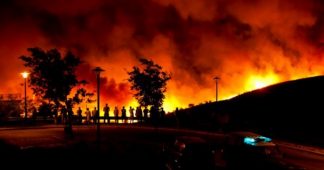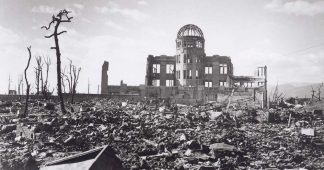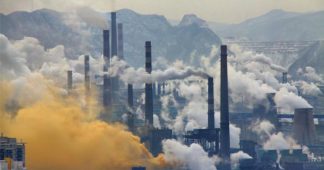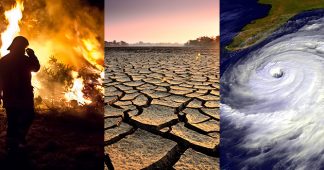The West is engulfed in flames.
A 14-square-mile fire in Glacier National Park has destroyed a historic backcountry lodge and towns from Boise, Idaho to Missoula, Montana are covered in smoke from nearby fires. Residents are cautioned to stay indoors due to unhealthy air quality.
Down in Yosemite, a 15-square-mile wildfire is burning around a grove of 2,700 year old sequoias.
Up in Washington a fire is blazing near Mount Rainier National Park, which grew to more than 29-square-miles over the weekend. Ash is falling in Seattle for the first time since the eruption of Mount St. Helens in 1980.
A man-made fire in Oregon, allegedly caused by fireworks, is burning out of control through the Columbia River Gorge, which had reached 10,000 acres as of this writing and is devastating Eagle Creek, one of the most scenic and revered hiking areas in Mount Hood National Forest. The flames in the Gorge are now threatening the Multnomah Falls Lodge, a popular destination for tourists.
Many more fires are spreading fast from California to New Mexico to Colorado, with little reprieve in sight.
Like the intensified hurricanes in the Atlantic, forest fires in the Western U.S. are getting worse every summer because our climate is in peril. Below is a piece I wrote in 2013 on this destructive and deadly new norm. – JF
Montana, 2013
As my wife Chelsea and I drove through Arizona on our annual pilgrimage from California to Montana, orange smoke billowed along the darkened horizon, signals of hearts shattered and landscapes scorched. Days earlier nineteen hot shot firefighters died together as they battled the intense blazes near the mountain town of Yarnell. It was the most lethal wildfire America had witnessed in 80 years.
The Yarnell flames were so erratic and intense the team became suddenly trapped, and despite each of the men deploying their individual fire shelters, all fighting the flames that day perished. The lone survivor was out fetching a truck for his crew, only to return to the gruesome scene to find his buddies were gone. It was the single deadliest incident for firefighters since the 9/11 attacks on the World Trade Center.
Fires like the one that charred the small Yarnell community are only growing in size and ferocity in the West. According to the National Interagency Fire Center, the number of wildfires every year in the U.S. has remained relatively steady, but their size has increased dramatically. In 1987, a little over 2.4 million acres burned across the country whereas 2012 saw over 9.3 million acres go up in flames. That’s more than the size of Rhode Island and Maryland combined and it’s a trend many see as only increasing as more droughts plague Western states and climate change continues to rear its ugly head.
“Today, western forests are experiencing longer wildfire seasons and more acres burned compared to several decades ago,” says Todd Sanford, a climate scientist at the Union of Concerned Scientists (UCS). “The greatest increase has occurred in mid-elevation Northern Rockies forests, which are having higher spring and summer temperatures and earlier snowmelt. These conditions are linked to climate change.”
Seven of the largest fires since 1960 have occurred over the last twelve years. As these fires get larger, more homes, particularly those built in fire zones, are being lost. For example, this year’s Black Forest Fire in Colorado consumed over 500 homes, while last year’s Waldo Canyon Fire, only a few miles away, burned almost 350 houses. Even the U.S. Forest Service is beginning to hone in on the real culprit behind the intensified flames.
“We’re seeing more acres burned and more burned in large fires,” says Dave Cleaves, climate-change adviser for the U.S. Forest Service. “The changing climate is not only accelerating the intensity of these disturbances, but linking them more closely together.”
Rising summer temperatures are exacerbating drought conditions and increasing pests like mountain pine beetles, which are ravaging Western forests and killing trees that in turn provide fuel for wildfires. Drought conditions in Arizona have been so bad over the past twenty years that trees like evergreens, manzanitas, oak and mahogany are drying up, becoming increasingly susceptible to fire.
Predictably, the Forest Service argues that fires could be mitigated with increased fuel reductions, ie “logging”. But the fact is, under extreme fire weather conditions virtually all fuel reductions fail, and what we are seeing today is certainly extreme.
“Even a degree or so warmer, day in day out, evaporates water faster and that desiccates the system more,” says University of Montana fire ecologist Steve Running.
Professor Running knows his numbers. Over the past 10 years temperatures have risen 1.6 degrees Fahrenheit across the continental United States, with certain states out west seeing an even larger jump. Arizona’s average annual temperature, for instance, has risen 2.3 degrees. Yet, even as it gets warmer and fires burn hotter, people are continuing to build homes in fire-prone areas. And no real entity is putting a stop to it. Banks are not evaluating loans based on the potential for wildfire and homeowners are having little trouble insuring their properties despite being built in the path of potential flames.
As climate change increases fire activity, it is also contributing to the Forest Service’s efforts to battle fires. In the last ten years firefighting staff at the agency doubled. Currently 40% of the Forest Service’s annual budget is allocated toward battling wildfires at over $2 billion a year. The agency’s staff has a lot of ground to cover, about 231 million acres of public forest land alone has a moderate to high fire risk. Of course, most of the focus is on protecting areas where homes are vulnerable. According to the Forest Service chief Thomas Tidwell, the number of houses built within half a mile of national forests exploded from 484,000 in 1940 to 1.8 million in 2000. That’s a lot of property to protect at taxpayer’s expense.
According to the Fannie Mae Foundation, which is not exactly a foe to development, Denver ranked fourth in the country for urban sprawl in 2000, trailing only Atlanta, Miami and Detroit. Fannie Mae cited these cities as spreading outside their urban centers at a dangerous rate. Strip malls line the Denver suburbs, where the housing developments are reminiscent of the endless tract homes of Orange County, California. Much of this vast expansion has pushed communities into fire prone habitat that is affected by pine beetle infestations.
Winter temperatures aren’t as cold as they used to be in the Rocky Mountains or in the Pacific Northwest, glaciers are melting and snow packs are decreasing faster than normal. As such, insects like the native pine beetle are surviving the winter months and thriving once spring rolls around, which is becoming earlier every season. The Forest Service estimates that areas in Colorado affected by pine beetles is around 3.4 million acres, which almost matches the combined 3.7 million that presently impact Wyoming and South Dakota. The Forest Service notes that the pace has slowed somewhat, but that’s only because mature trees in the outbreak hotspots have already been killed off.
Having grown up in and around Western forests, the epidemic is apparent at first glance. Discolored trees pepper forest landscapes with brown and orange hues. It’s a spooky climate change omen. It’s as if these coniferous pines have somehow turned deciduous.
Colorado’s ritzy Beaver Creek Resort, 100 miles west of Denver, is one of the many places where the pine beetle has left its deadly mark. “We can’t stem the tide,” Tony O’Rourke, executive director of Beaver Creek’s Home Owners Association told Newsweek in 2008.
The solution to protect Beaver Creek’s multi-million dollar homes O’Rourke represents? Clear-cutting. No trees means no fires. Of course, allowing fires to burn would be a healthier way to manage the problem, but O’Rourke and others aren’t about to risk losing their mountain mansions.
According to a study by CoreLogic, Colorado is number three of 13 Western states for the most high-risk homes insured, trailing only California and Texas. The study indicated there are over 121,000 homes in Colorado that were built in or near forest land. A whopping 2,000 structures have been burned in these so-called “red zones” since 2002. However, this hasn’t staunched development. From 2000 to 2010 almost 100,000 new homes were built in wildfire prone areas of Colorado, bringing the total number to 556,000.
***
After traversing state highways out of Colorado and north through Wyoming’s coal-country, stopping off in South Dakota’s Custer State Park, Chelsea and I head on up to my hometown of Billings, Montana. A dozen hours on these lonely highways and it is easy to see that the coal barons, developers and their allies are the West’s biggest menace. No longer is the air fresh, Wyoming’s unfettered gas drilling has made parts of the state’s air quality worse than Los Angeles’ on its worst days. Endless streams of coal trains roll past, piled to the brim with black rock bound for incinerators abroad. Wyoming’s Black Thunder mining pit, operated by Arch Coal, is the first mine to ship out 1 billion tons of coal. It’s a disgusting sight to see. This coal, of course, is one of the greatest contributors to global warming which is causing wildfires to worsen.
Author William Kittredge calls my home state of Montana the “Last Best Place,” but I often wonder how long his phrase will remain apt. The majestic ice formations of Glacier National Park, for instance, have been in retreat for years, victims of climate change. Massive fires are bound to follow. Some of the very glaciers I enjoyed in my youth, less than twenty years ago, are no longer around. Fish too may soon be casualties.
On the Madison River, where I cast my first fly, the number of days where the water temperature is dangerous for trout species (around 70 degrees) increased from six days a year in the 1980s to 15 over the past decade. It’s a sad reality for those that make their living entertaining wealthy Hollywood producers and Wall Street brokers on weeklong fishing expeditions along Montana’s mighty rivers: if trout numbers decline so will tourist dollars.
Pine beetles, as in most other Western states, are also destroying trees in Montana along with a staple food source for threatened grizzly bears. As CounterPunch author Doug Peacock has written, “During 2008, the bears suffered a double disaster: grizzlies died in record numbers and global warming dealt what could be a death blow to the bear’s most important food source. Some 54 grizzly bears were known to have died in 2008, the highest mortality ever recorded … Related to the high mortality of 2008 was the massive die off of whitebark pine trees, whose nuts are the bear’s principal fall food. Mountain pine beetles killed the trees; the warm winters of the past decade allowed the insects to move up the mountains into the higher whitebark pine forests.”
Wildfires in Montana have also increased over the past several decades. Over 2 million acres of forest land burned in 2007 and nearly 2 million more in 2012, a significant increase from the worst years of the 1980s and ’90s.
As humans continue to spew more carbon dioxide and methane into the atmosphere the world’s climate will continue to be altered. In fact, as many scientists believe, there may already be no turning back. Warmer winters, hotter summers, drought and burning forests (and the homes built in them) will soon be the new reality for the Western United States. The signs are already all around us. If you don’t believe me just take a little road trip through the Rocky Mountains to see the travesty for yourself.
Just remember to bring your camera so you can capture it before it goes up in smoke.











